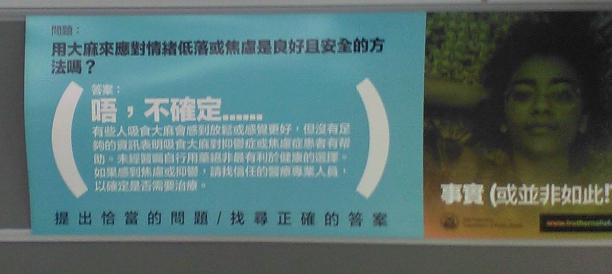Is this Cantonese, Mandarin, or a combination of the two?
« previous post | next post »
Sign on a municipal bus in San Francisco:

(Sponsored by truthornahsf.org)
This is a public service announcement cautioning people about the risk of self-medicating their moods (qíngxù dīluò huò jiāolǜ 情绪低落或焦虑 ["depression or anxiety"]) with marijuana. It starts at the top with a question — labeled as such (wèntí 問題) — in black characters asking if using marijuana is a "good and safe method" for treating such symptoms. What follows in white is the dáàn 答案 ("answer").
Some people would look at the line of four large characters in white and assume that it was at least partly Cantonese:
m4, bat1 kok3 ding6…
唔,不確定
"No, not necessarily so…"
But the wording on the rest of the sign is all in Mandarin, so I think that it would be better to read the line of four big characters as also being in Mandarin:
wú*, bù quèdìng
唔,不確定
"Hmm / well / um / uh / er, not necessarily so…"
*Some people might pronounce this as "n" or "ng" in the 2nd tone.
In the latter case, "wú 唔" is a particle of pause or reflection like "ǹg / ńg / ňg / ǹ / ń / ň 嗯", not the negative particle m4 唔 as in Cantonese.
Selected readings
"Differing Cantonese and Mandarin readings of the same headline" (4/30/18)
"The wonder of Cantonese particles" (5/14/18)
"Cantonese sentence-final particles" (3/23/17)
"Token Cantonese" (5/16/15)
See Donald B. Snow's remarkable Cantonese as Written Language: The Growth of a Written Chinese Vernacular (Hong Kong: Hong Kong University Press, 2003). Appendix 1 gives 14 Cantonese texts, each of which Snow carefully analyzes for the degree to which it adheres to the norms of spoken Cantonese rather than of written Modern Standard Mandarin (MSM). The 14 texts, which cover a wide range of genres, date from around the 17th century to the contemporary period. It is striking that the percentages of overtly marked Cantonese (and Snow is referring here not just to special Cantonese characters) in these 14 texts range from only 3% to 36%: 3, 4, 6, 7, 10, 11, 12, 20, 23, 23, 23, 28, 32, 36, for an average of 17%.
[h.t. Charles Belov; thanks to Bob Bauer, Don Snow, Abraham Chan, and Zeyao Wu]
Carl said,
May 23, 2019 @ 6:39 pm
My understanding is that SF has a large Cantonese speaking native population, so my guess is that it is Cantonese and the rest is Mandarin just because that’s the prestigious language.
Chas Belov said,
May 24, 2019 @ 1:37 am
As always, thank you for the explanation. I was vaguely aware that 唔 had a different meaning in Mandarin, but I had only actually previously seen it in Cantonese contexts so was not expecting it to be used as Mandarin.
John Swindle said,
May 24, 2019 @ 5:34 am
Follow the "sponsored by" link below the picture. Their English-language answer to the question in the sign starts with a noncommittal "(Meh…)", consistent with Mandarin 唔 'hmm' and inconsistent with Cantonese 唔 'no'.
Carl said,
May 24, 2019 @ 9:14 am
The website in English is called "Truth or Nah". My theory is that the person who wrote the sign knows Cantonese but considers it to be a dialect and therefore 唔 would be an equivalently colloquial way of saying "Nah", not a different language in its own right.
This is an interesting mystery. Maybe we should reach out to ask who wrote it.
John Swindle said,
May 26, 2019 @ 6:15 am
@Carl: You can solve the mystery. Go to the website. Look at the questions and how they answer the questions. The answers are either (Truuu) or (Naaaaaah!) or (Meh…), in each case followed by an explanation. The question on the sign, about anxiety and depression, gets a (Meh…), not a (Naaaaaah!).